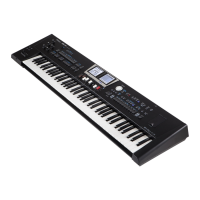To commit your changes (Freeze Data)
101
Common
The “Common” parameters on this page apply to the entire song or
rhythm.
1. Use the dial to edit the parameter in the “Common” page.
Left Display
The following parameters are available:
Parameter Setting Meaning
Reverb Type
Original
Original This setting means that the song
uses its own (programmed) reverb settings.
Room1,
Room2,
Room3
These types simulate the reverb
characteristics of a room. The higher the
number (1, 2 or 3), the bigger the “room”
becomes.
Hall1,
Hall2
These types simulate the reverb of a small
(1) or large (2) concert hall and thus sound
much “bigger” than the Room types above.
Plate
This algorithm simulates the acoustics of a
concert hall.
Delay
A delay eect (no reverb). Works a lot like
an echo eect and thus repeats the sounds
Pan Delay
This is a stereo version of the above delay
eect. It creates repetitions that alternate
between the left and right channels.
Reverb Level -127~0~+127
These parameters allow you to modify the
output level of the Reverb processor.
Chorus Type
Original
The song uses its own (programmed)
chorus settings.
Chorus
1~4
These are conventional chorus eects that
add spaciousness and depth to the sound.
Fbk Chorus
This is a chorus with a anger-like eect
and a soft sound.
Flanger
This is an eect that sounds somewhat like
a jet airplane taking o and landing
ShortDly
This is a full-edged delay eect that can
be used instead of a chorus or anger. As
you will see, there are a lot of parameters
you can program
ShortDlyFb This is a short delay with many repeats
Chorus Level -127~0~+127
These parameters allow you to modify the
output level of the Chorus processor.
Rhythm
Volume/Song
Volume
-127~0~+127
This parameter allows you to set the overall
volume of the selected rhythm or song if
you think it is too loud/soft.
Rhythm
Tempo/Song
Tempo
20~250
Allows you to change the rhythm’s or
song’s tempo
Key -12~+12
This parameter allows you to transpose
all song parts (except the drums) up to
12 semitones (1 octave) up or down. This
value is written to the song data and used
every time you play back this song.
NOTE
This parameter is not available for
rhythms.
Parameter Setting Meaning
Undo
Changes
Select this entry to cancel all “Rhythm/SMF
Makeup Tools” settings you have made and
to revert to the previously saved version.
To commit your changes (Freeze
Data)
Before saving your “made-up” rhythm/song to a USB memory, you
can (but you don’t have to) “commit” your changes, thereby turning
them into “regular” rhythm or song data.
This may come in handy if you also want to play back your new
rhythm/song version on another backing instrument, sequencer or
your computer. This operation is unnecessary for les you only want
to use with the BK-9 or one of the Roland backing models.
1. Press the [QUICK MENU] button.
Left Display
2. Use the dial to select “Freeze Data“ and push it.
A message conrms that the data have been committed.
Saving Your New Rhythm or Song
(SMF) Version in USB Memory
MEMO
You will need an optional USB memory to save your new rhythm
or song (SMF).
NOTE
Use USB memory sold by Roland (M-UF-series). We cannot
guarantee operation if any other USB memory is used.
1. If you are happy with your changes and wish to preserve
them, press the [QUICK MENU] button.
2. Use the dial to select the “Save” parameter and push it.

